

Passover and the Crucifixion. The death and resurrection of Jesus is central to the Christian faith.
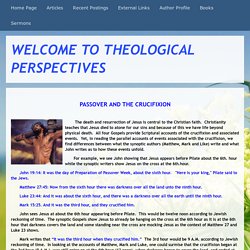
Christianity teaches that Jesus died to atone for our sins and because of this we have life beyond physical death. All four Gospels provide Scriptural accounts of the crucifixion and associated events. Yet, in reading the parallel accounts of events associated with the crucifixion, we find differences between what the synoptic authors (Matthew, Mark and Like) write and what John writes as to how these events unfold.
For example, we see John showing that Jesus appears before Pilate about the 6th. hour while the synoptic writers show Jesus on the cross at the 6th.hour. PASSOVER SACRIFICE. The sacrifice which the Israelites offered at the command of God during the night before the Exodus from Egypt, and which they ate with special ceremonies according to divine direction.
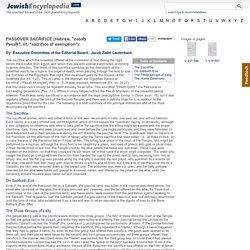
The blood of this sacrifice sprinkled on the door-posts of the Israelites was to be a sign to the angel of death, when passing through the land to slay the first-born of the Egyptians that night, that he should pass by the houses of the Israelites (Ex. xii. 1-23). This is called in the Mishnah the "Egyptian Passover sacrifice" ("Pesaḥ Miẓrayim"; Pes. ix. 5).
It was ordained, furthermore (Ex. xii. 24-27), that this observance should be repeated annually for all time. This so-called "Pesaḥ Dorot," the Passover of succeeding generations (Pes. l.c.), differs in many respects from the Pesaḥ Miẓrayim. In the pre-exilic period, however, Pesaḥ was rarely sacrificed in accordance with the legal prescriptions (comp. The Sacrifice. On Sabbath Eve. The Mysterious Ceremony Involving a Red Heifer Explained - Hoshana Rabbah BlogHoshana Rabbah Blog. Numbers 19:1–11.

The red heifer. The Overview of the Ceremony and Its Greater Implications The Jewish sages teach that the commandment (mitzvah) of the red cow is “beyond human understanding.” Like the afikoman (the middle broken matzah that is “buried” and “resurrected,” which is a picture of the death, burial and resurrection of Yeshua) in the Passover (Pesach) Seder, the meaning of which to this day remains unclear to the Jewish scholars, the red cow is a ritual that makes sense only when Yeshua the Messiah is added to the picture. While the symbolism of the red heifer was, to Jewish Torah scholars, admittedly incomprehensible to human reason, by the second temple era they began to speculate about its spiritual significance in their aggadic literature. The Joyous Water-Drawing Ceremony - Simchat Beit Hashoeivah - Sukkot & Simchat Torah. He who has not seen the Water-Drawing Celebration has never seen joy in his life (Talmud) Every Jewish festival is celebrated with joy.
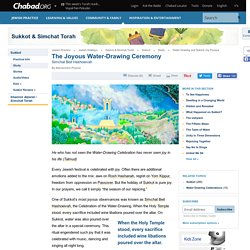
Often there are additional emotions added to the mix: awe on Rosh Hashanah, regret on Yom Kippur, freedom from oppression on Passover. Sukkot: A Promise of Living Water - Jews for Jesus. Fruit Harvest in Ancient Israel When summer is gone, the final harvest is ready.

Nimble fingers separate grapes from the vines. Some of the harvest is laid out for the sun to sweeten into delicious dried fruit: raisins. Huge quantities of grapes are crushed and their juice is stored in large earthen vats until the proper time for it to be poured into wineskins to complete the fermentation process. The Red Heifer. Hope of Israel Ministries (Ecclesia of YEHOVAH): The Red Heifer by HOIM Staff According to Scripture, the greatest defilement of all is death.

Therefore, the sin offering for its purification was itself the most marked. Sin renders fellowship with YEHOVAH God impossible; sin was death; it causes death (Romans 6:23). Significance of the Red Heifer. Significance of the Red Heifer: Christ Crucified Outside the Camp by Gerald L.
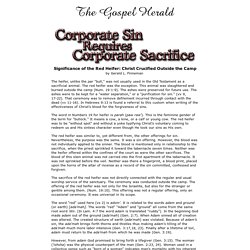
Finneman The heifer, unlike the par "bull," was not usually used in the Old Testament as a sacrificial animal. The red heifer was the exception. This animal was slaughtered and burned outside the camp (Num. 19:1-9). The ashes were preserved for future use. The Rites of the Red Heifer - TheTorah.com. The Mysterious Ceremony Involving a Red Heifer Explained - Hoshana Rabbah BlogHoshana Rabbah Blog. Ashes and Water - About a calf called death and its mother - From The Chassidic Masters. Certainly the most esoteric chapter in Torah are the laws of the "Red Heifer" (Parah Adumah), commanded by G‑d to Moses in Numbers 19 as an antidote to the state of ritual impurity engendered by contact with death.
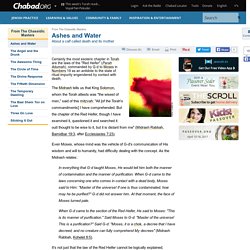
The Midrash tells us that King Solomon, whom the Torah attests was "the wisest of men," said of this mitzvah: "All [of the Torah's commandments] I have comprehended. But the chapter of the Red Heifer, though I have examined it, questioned it and searched it outI thought to be wise to it, but it is distant from me" (Midrash Rabbah, Bamidbar 19:3, after Ecclesiastes 7:23). Even Moses, whose mind was the vehicle of G‑d's communication of His wisdom and will to humanity, had difficulty dealing with the concept. Red heifer - Wikipedia. The Red Heifer (Hebrew: פָרָ֨ה אֲדֻמָּ֜ה; para adumma), also known as the red cow, was a cow brought to the priests as a sacrifice according to the Hebrew Bible, and its ashes were used for the ritual purification of Tum'at HaMet ("the impurity of the dead"), that is, an Israelite who had come into contact with a corpse.[1] Hebrew Bible (Torah)[edit] Book of Numbers[edit] According to: "Speak unto the children of Israel, that they bring thee a red heifer without spot, wherein is no blemish, and upon which never came yoke".Numbers 19:2 In order to purify a person who has become ritually contaminated by contact with a corpse, water from the vessel is sprinkled on him, using a bunch of hyssop, on the third and seventh day of the purification process.
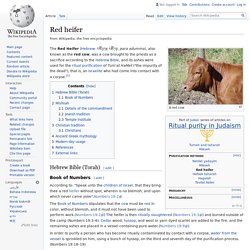
(Numbers 19:18–19) The priest who performs the ritual then becomes ritually unclean, and must then wash himself and his clothes in running waters. Mishnah[edit] Red heifer - Wikipedia. Untitled. Water ceremony jewish temple. The Joyous Water-Drawing Ceremony - Simchat Beit Hashoeivah - Sukkot & Simchat Torah. Water Libation Ceremony. The Water Libation Ceremony, known as Nissuch Ha-Mayim in Hebrew, was one of the most popular parts of the celebration of the Feast of Tabernacles.
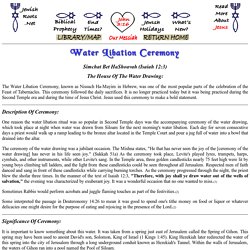
This ceremony followed the daily sacrifices. It is no longer practiced today but it was being practiced during the Second Temple era and during the time of Jesus Christ. Jesus used this ceremony to make a bold statement. One reason the water libation ritual was so popular in Second Temple days was the accompanying ceremony of the water drawing, which took place at night when water was drawn from Siloam for the next morning's water libation. Each day for seven consecutive days a priest would walk up a ramp leading to the bronze altar located in the Temple Court and pour a jug full of water into a bowl that drained into the altar. WATER-DRAWING, FEAST OF. Sukkot: A Promise of Living Water - Jews for Jesus.